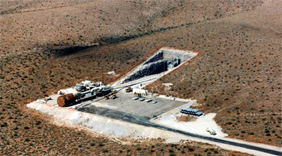 For the
past two decades, engineers and scientists have studied Yucca Mountain to determine
whether the site is viable and safe for a federal nuclear waste storage facility
for the next 10,000 years. Geologists have characterized the setting using a
variety of physical samples, observations and models, addressing everything
from how water percolates through the hydrologic system, to whether and how
it might corrode containers storing the nuclear waste.
For the
past two decades, engineers and scientists have studied Yucca Mountain to determine
whether the site is viable and safe for a federal nuclear waste storage facility
for the next 10,000 years. Geologists have characterized the setting using a
variety of physical samples, observations and models, addressing everything
from how water percolates through the hydrologic system, to whether and how
it might corrode containers storing the nuclear waste. E-mail exchanges sent between 1998 and 2000, by unnamed U.S. Geological Survey scientists, reveal possible data fabrications during the federal quality assurance procedure for the Yucca Mountain nuclear waste repository. Image courtesy of DOE.
That body of work was called into doubt in mid-March, when lawyers for the Department of Energy (DOE), which contracts with scientists from the U.S. Geological Survey (USGS) and elsewhere, discovered that USGS employees working on Yucca Mountain’s hydrology may have falsified documentation of their work. The allegations came with the discovery of e-mails that discuss possible misrepresentations and falsifications. As part of a standard review of materials relating to the licensing for the repository site, the Nuclear Regulatory Commission (NRC) requires all nonconfidential documentation be posted online. Sources from USGS say that 20 e-mails are in question, sent between 1998 and 2000, by USGS scientists working on models of water infiltration at the site.
The House of Representatives Subcommittee on the Federal Workforce and Agency Organization released some of the e-mails, from DOE and Department of the Interior (DOI) sources, on April 1. In their correspondence, unidentified scientists wrote about making up dates for when models were installed on their computers to fulfill “quality assurance” procedures. They also discussed having “fixed” models, deleted incongruous results and re-run simulations because mistakes were found in the initial input data without reporting them in the procedures.
Quality assurance is a rigorous process in which engineers and scientists must document every step of their work, under attentive supervision, and such procedures have been problematic for the project in the past. Project scientists have more than a thousand datasets, hundreds of software programs and about 60 models for simulating the repository’s performance, says Daniel Feehan of the Government Accountability Office (GAO). A clear “chain of custody must be evident in the documentation supporting the scientific work even when the smallest changes are made to a line of code or data set,” says Feehan, who wrote a review of DOE quality assurance problems last year.
Regarding the quality-assurance requirement that scientists keep detailed “scientific notebooks,” one USGS worker wrote in an e-mail, “I can start making something up” to document an entirely electronic modeling process, in order to satisfy auditors.
Culturally, geologists don’t keep notebooks documenting their every step, says Allison MacFarlane, a geologist who is a Yucca Mountain expert in the Security Studies Program at MIT. She also points out that the e-mail text may be taken out of context, and that some points are being ignored in media reports, including the fact that these are models, not hard data. “I’m not convinced that bad science has been done,” she says. “I’m convinced there’s a lot of frustration [from] scientists at USGS working with DOE,” something that has been a problem in the past.
Indeed, Feehan says, despite ongoing work at Yucca Mountain for two decades, the scientific culture seemingly has not yet adapted to the review process. He also says, however, that tracking a scientific setting where natural systems are the subject is much more difficult than tracking a nuclear power plant that incorporates basic engineering and known manufactured components.
In the meantime, the allegations have raised hackles in the political realm. Senators Harry Reid (D) and John Ensign (R) of Nevada, who strongly oppose the Yucca Mountain project, immediately attacked the science, saying that the falsifications call the whole project into question. “Yucca Mountain has been plagued by quality assurance problems for years,” Reid said in testimony at a hearing in the House Subcommittee on the Federal Workforce and Agency Organization on April 5. “It is abundantly clear that there is no such thing as sound science at Yucca Mountain.”
Bob Hirsch, associate director of the water division at USGS, calls the research by USGS scientists at Yucca Mountain over the past 20 years “cutting edge.” The e-mails, however, have “potentially serious consequences for these employees,” he says, and for the survey.
Meanwhile, the inspectors general of the departments of Energy and the Interior are conducting separate reviews of the e-mails, to determine exactly what happened; a process is also in place to review whether the science has been compromised. USGS Director Chip Groat declined to discuss the issues until the DOI inspector general’s report is complete, but, he said at the April 5 hearing, “I take these charges seriously, and will do everything I can to ensure that the scientific information the USGS provides to the nation meets the highest standards of accuracy and credibility.”

